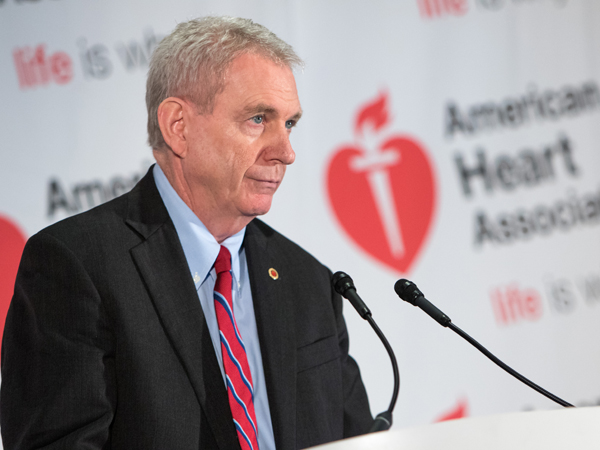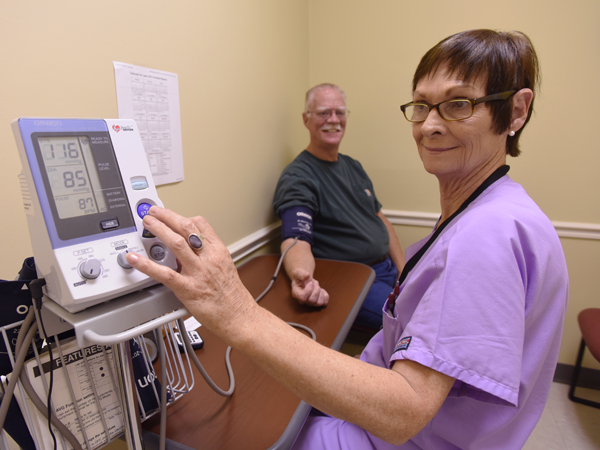SPRINT leads to new blood pressure guidelines

Published in News Stories on November 23, 2015
When the results of the landmark SPRINT study were released by the American Heart Association on November 9, it made national headlines. In the midst of the breaking story, leading the discussion, was the University of Mississippi Medical Center's Dr. Daniel Jones.
“This is likely the most important blood pressure study in the past 40 years,” Jones, professor of medicine and physiology and interim chair of the Department of Medicine, told the AHA Scientific Sessions meeting in Orlando, Florida.
“It was a real honor and privilege [to give the faculty presentation],” said Jones. He was not an investigator with the study, but he is a former president of the AHA and an expert on hypertension, placing him in prime position to discuss the results.
“It's one that should and will change the practice of treating high blood pressure around the world,” Jones said. The AHA now recommends 120/80 mm Hg (millimeters of mercury) as a treatment goal, based on greatly decreased risk for cardiovascular disease and death.
The Systolic Blood Pressure Intervention Trial (SPRINT) commenced in 2009 to determine appropriate blood pressure targets to reduce cardiovascular disease related to hypertension, defined as blood pressure higher than 140/90. Over 100 sites across the United States participated, sponsored by the National Heart, Lung, and Blood Institute (NHLBI).

Cathy Adair, clinical research manager, checks the blood pressure of Lamar Adair (no relation) as part of the SPRINT study. Lamar was part of the 140/90 mm Hg treatment group.
UMMC hosted one of the SPRINT clinical sites. Dr. Zeb Henson, associate professor of internal medicine, pediatrics and hypertension, and Dr. Marion Wofford, professor of internal medicine and hypertension, have served as principal investigators for the site, while registered nurse Cathy Adair was the clinical research manager.
In the national study, over 9,300 participants were assigned one of two treatments: a standard high blood pressure treatment goal of 140/90 mm Hg, and another with the intensive lower goal of 120/80. Each group had their blood pressure measured every three months and took medications to reach the target levels based on those measurements.
According to Adair, UMMC has 83 individuals participating in the trial.
SPRINT was set to run until 2017, but preliminary findings were so convincing that trials ended in August. The full results were announced as a late-breaking clinical trial at the AHA meeting.
Study directors were surprised to find that incidence of cardiovascular problems was 25 percent lower in the 120/80 group. The numbers were even more compelling for heart failure and cardiovascular disease-related deaths, at 38 and 43 percent lower, respectively, for that same group. Death from any cause was also 27 percent lower in the intensive treatment group.
Does this mean that everyone should set 120/80 as their blood pressure goal? Not necessarily. The study only included people age 50 and older with elevated blood pressure and risk for cardiovascular disease, but without type II diabetes or history of stroke. Ongoing research in other projects will help determine safe and effective targets for more groups.

Cushman
“There are several groups, who in aggregate constitute a large percent of the adult population, for whom extension of the SPRINT findings would be more speculative,” said Dr. William Cushman, study leader based at the Veteran's Affairs Medical Center in Memphis and 1974 graduate of UMMC, in an editorial published in the journal Hypertension.
This includes people with prehypertension, or systolic blood pressure between 120-139 mm Hg. It is unclear if the health benefits of lowering their blood pressure outweighs associated risks.
In short, patients should ask their physician about the treatments and targets best for them.
The AHA and the American Medical Association are collaborating on a first-of-its-kind program to support physicians treating hypertensive patients. The initiative, called Target: BP™, will promote a target of less than 140/90 mm Hg, the current guideline. The SPRINT results were an important factor in this decision, said the AHA in a press release. According to the AHA, it is an innovative step towards improving treatment for the millions of Americans with hypertension.

Jones discusses the SPRINT results at the American Heart Association Scientific Sessions meeting in Orlando, FL on November 9.
New blood pressure management guidelines are now being prepared by AHA and the American College of Cardiologists. Jones, who is a participant in the 20-member panel, says the new guidelines will likely be published next fall. He expects some clinicians to wait until then to adopt the 120/80 standard for their own practices, while others will be early adopters.
“I think you can expect many clinicians will look at the results of the SPRINT trial and will move forward with making decisions on many of their patients, especially those at high risk, for more aggressive lowering of blood pressure," said Jones.
The SPRINT study, “A randomized trial of intensive versus standard blood-pressure control” was published online in the New England Journal of Medicine on November 9. The research was supported by the National Institutes of Health and the Department of Veteran's Affairs.


